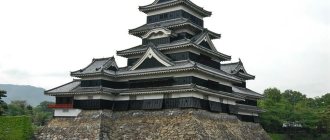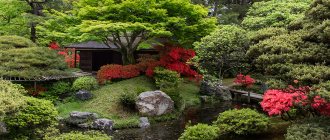If you want to make a Japanese garden at your summer cottage, you need to understand the planning principles used in oriental design. It doesn't have the usual concrete paths and doesn't look like your standard grassy barbecue area. This is a small and harmonious little world, perfectly integrated into the landscape, created specifically for a leisurely relaxation.
Honbo Garden. Osaka, Japan.
Japanese gardens are extremely popular all over the world, they can be seen both in ordinary private homes and next to historical landmarks, such as Buddhist temples or old castles. In Japan, gardening is a high art, which originated under the influence of the more ancient Chinese garden culture. Below is a selection of 20 stunning Japanese gardens from around the world.
Figurative symbolism of the Japanese garden
Considering the harmonious oriental landscape, Europeans sometimes do not know the meaning of many of its elements. The philosophy of the Japanese garden will be clearer if you learn to read the information encrypted by Eastern sages. Here are examples of common symbols:
- A sandy area
, carefully combed with special rakes - a surface of water with waves. - Garden paths
are the path of life. - Flat stones on the paths
- a journey without obstacles. - Small pebbles
are hills. - A group of large boulders
is a mountain range. - A gravel area surrounded by stones
is a sea bay. - Dark brown gravel
is the earth's surface. - A waterfall
is the beginning of life's journey. - Topiary bushes
are rounded mountains.
Ritsurin Garden, Takamatsu. Japan.
A real Japanese garden has several characteristic features. The most important thing is that the house should always be located in the middle of the plot so that the entire garden can be viewed from it. Also, in a traditional Japanese garden there are the following attributes:
- A pond - real or artificial. Possibly parched.
- A bridge over a body of water, or stones laid out along the bottom to cross a body of water.
- Stones or stone compositions.
- Lantern, mostly made of stone.
- Tea room or gazebo.
- A fence, wall or hedge in a traditional style.
Ogrod Japonski (Warsaw, Poland)
0
In 1913, the World Exhibition was held in Warsaw, and the Japanese Garden, which was part of its exposition, created a real sensation: it was the first such facility in Eastern Europe. The initiators of its creation were Count Fritz von Hochberg, an expert and lover of Japanese culture, and professional gardener Mankishi Arai. But, unfortunately, after the end of the exhibition the garden did not receive further development, and due to the First World War it was completely abandoned.
0
The authorities of the Polish capital decided to restore it only in 1994, for which they asked for help from the Japanese embassy. The then Japanese Ambassador Nagao Hyodo eagerly took up this matter, and in 1996 a team of gardening specialists arrived from Nagoya to Warsaw. With their help, the Japanese Garden opened to the public the following year. But it delighted the public for only two months and was almost completely destroyed by a flood in 1997.
0
The Polish authorities again set about restoring the garden, and again with the help of the Japanese. Thanks to joint efforts, two years later the Japanese Garden welcomed visitors again - and still welcomes them.
Karakuen Garden. Okayama, Japan.
Initially, for the Japanese, a garden is a place of relaxation, contemplation and unity with nature, but modern public gardens are used both for walking and for preserving some rare plant species. The structure of the Japanese garden emphasizes the extraordinary fragility of nature and encourages its conservation.
Stones play a very important role in this culture. They are used mainly to create paths and bridges. Large stones, usually triangular in shape, are placed separately. They are a symbol of the mountains.
Artificial reservoirs are constructed in such a way as to be as similar as possible to natural lakes and streams, which is why the Japanese practically do not use fountains. You can often find artificially created, dry reservoirs, made to look as if there were actually water babbling in them.
One of the main elements of a Japanese garden is vegetation. The Japanese prefer to plant plants with rich green foliage, but colorful flowering trees and flowers also have their place.
Thanks to the different types of maples and shrubs, the Japanese are able to create a variety of color palettes in their gardens.
Japanese style rules
This type of landscape is radically different from the lush European garden compositions we are accustomed to. The Japanese garden is arranged according to traditional rules, but the owners of the site still have room for imagination. For example, even the obligatory presence of a water surface can be embodied in symbolic form by constructing alternative dry ponds and streams from calibrated or river gravel.
Features of the Japanese garden:
- Maximum natural outlines of all decorative elements without the use of strict lines. For example, if you are laying a stone path, then make it winding.
- A mandatory combination of water and rough stone.
- The coloring of vegetation and accessories is mostly restrained.
- A Japanese walking garden is created for contemplation, and not for active recreation; there is always an open area for meditation.
- The landscape should look harmonious all year round.
- Use of oriental accessories.
Aesthetics of park ensembles
The unique Japanese aesthetic of traditional gardens stems from Zen Buddhism. The influence of religion from China occurred in two stages. The first trends of Buddhism in the country date back to the Tang Dynasty, Zen concepts came from the Chinese Song era. Japanese monks returning from China brought teachings, and with them objects of art, which were highly valued by the aristocracy, believers and warriors of that time. The influence on the art and architecture of Japan was incredibly impressive and lasting.
The aesthetic value of Japanese style lies in its apparent simplicity, naturalness, and sophistication. It is distinguished by a traditional style and the use of suggestive symbols rather than straightforward solutions. Monastic garden and park ensembles representing the “Way of Zen” are famous for the use of asymmetry, with the use of perfect forms and the use of odd elements of compositions.
In order to grasp the essence of things, all non-essential elements must be discarded. The fine art of that era, expressed in black sumi ink, convinced connoisseurs that monochrome images allowed one to see endless variations of shades. This trend carried over into Japanese garden aesthetics, where monochromatic green predominated. The flowers were intended only to emphasize and enhance the value of the main color.
Symbolism in Japanese landscape design
Since Japan, due to its geographical location, is a group of islands surrounded by seas and oceans, water as a design element is crucial. One of the most popular garden styles is "chisen". In such places for relaxation and contemplation, a pond or lake occupies the most significant part. It is based on the concept of the necessity and importance of water not as a substance, but as a symbol of life. In this case, the amount of water is not so important as its presence is necessary. If there is a shortage of space, the opportunity to contemplate water is realized in a small stone container. In dry gardens of the Karesansui style, the presence of water as such is not necessary. In such spaces, the sea is symbolized by gray gravel or sand with a pattern applied to it.
A sea without islands is unthinkable, and in creating such islands the Japanese owe much to landscape design concepts borrowed from China. One of the earliest styles was "shumisen-shiyo", Utopia or a sacred place removed from ordinary human society. In gardens following this tradition, the island of immortal and eternal happiness, called Horaisan or Horaijima, became an important element. In later interpretations of Buddhism, the sacred island was replaced by a legendary mountain on which the Buddha was believed to have lived.
Cranes and turtles, according to Chinese mythology, are symbols of longevity. Often the shape of the islands resembles precisely these representatives of the fauna, which are the embodiment of favorable circumstances and longevity. Another auspicious symbol is Kibune, a treasure ship that sails the seas. In installations it is often represented as a group of stones. Such islands, due to their sacred nature, are inaccessible to humans. In addition to sacred ones, parks may have islands connected to the main territory by bridges. They often house tea gazebos. In dry gardens, or rock gardens, islands are composed of interestingly shaped rocks set in the sand. Groups of stones can be located close to the edge of a pond or its symbolic image.
The symbol of the trinity of Buddha is represented in ensembles by three vertically located stones. The largest stone, which is always in the center, represents the Buddha, and the two smaller ones placed side by side represent the Bodhisattvas.
The trees and plants used in the garden are closely intertwined with the spiritual and physical life of the Japanese people. Pine is the main structural wood. Traditionally it is called "Tokiwa" - evergreen. Pine symbolizes longevity and happiness. Black and red pines represent positive and negative forces in the world. Japanese black, or male, pine symbolizes the past, and red, or female, symbolizes the future.
Bamboo and plum trees are often featured in the composition. The combination of pine, bamboo and plum symbolizes favorable circumstances. Plum is the embodiment of energy and a symbol of patience, thanks to its ability to bloom early after a harsh winter.
Mini gardens
In landscape design, very often the style of the types mentioned at the beginning of the article is used to create mini-gardens. In this way, not the entire site is decorated in Japanese style, but only part of it. This is a great way to create a corner of Japan on your site without changing the existing landscape design. Let's look at some of the most common options for mini-gardens.
Tsubo garden Translated from Japanese it sounds like “jug”. In accordance with the name, it is located in a very small area in a secluded corner of the garden. A stylistically recognizable, full-fledged Japanese garden is created on an area of several square meters.
The only thing that distinguishes a tsubo garden from a large Japanese garden is that it is better to plant plants of the same type. For example, only bamboo.
Tea garden
The place where the tea ceremony is held. A “tsukubai”, a tea pavilion, and a low bench without a back (machiaya) are required. The simpler and more modest the tea garden looks, the better. Nothing should distract from the ceremony. The main condition is cleanliness and grooming.
Rock garden
The stone garden carries a deep philosophical load, and therefore requires familiarization with the basics and principles. It is an odd number of stones (simulating islands), laid out in a certain order on the sand (simulating the sea). Requires careful care and even watering.
bonsai garden
It can be arranged throughout the entire territory of the site, or you can occupy only a very small, no more than a meter, piece of land with dwarf trees. In the bonsai garden, pots contain the most ordinary trees, which are grown by trimming the crown and roots in a special way. As a result of this “molding”, the tree grows dwarf, with the crown shape conceived by the owner.
Setting up a Japanese garden is not an easy task, requiring not only material costs, but also spiritual efforts. But as a result, the site will turn into a corner of peace, tranquility, harmony with the world and oneself.
- ← Stones in landscape design
- Japanese garden on a country plot →











